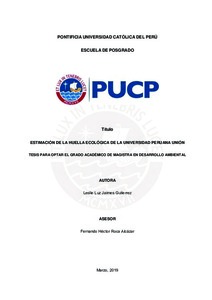| dc.contributor.advisor | Roca Alcázar, Fernando Héctor | |
| dc.contributor.author | Jaimes Gutierrez, Leslie Luz | es_ES |
| dc.date.accessioned | 2019-08-29T16:23:25Z | es_ES |
| dc.date.available | 2019-08-29T16:23:25Z | |
| dc.date.available | 2019-08-29T16:23:25Z | es_ES |
| dc.date.created | 2019 | es_ES |
| dc.date.issued | 2019-08-29 | es_ES |
| dc.identifier.uri | http://hdl.handle.net/20.500.12404/14862 | |
| dc.description.abstract | El consumo sostenible implica satisfacer nuestras necesidades de bienes y servicios, presentes y
futuras, de tal modo que sean sostenibles ambiental, económica y socialmente. La Huella
Ecológica (HE) es un indicador útil en este campo pues ayuda a identificar los impactos de una
población o una actividad mediante la determinación de la superficie necesaria para mantener su
ritmo de consumo de recursos y asimilación de desechos. Las universidades no son ajenas a las
tendencias actuales de consumo y debido al alto impacto en su comunidad e influencia hacia el
exterior, es relevante realizar investigaciones como la presente que se desarrolla en la Universidad
Peruana Unión (UPeU). La presente investigación tiene como objetivo estimar la HE de la UPeU
en el periodo 2017, basando los cálculos en el análisis de 05 variables: agua, energía eléctrica,
superficie construida, papel y movilidad. Para realizar este análisis se utiliza la metodología
propuesta por López y Blanco, a partir de los consumos y sus emisiones para luego obtener la
superficie requerida para absorber el dióxido de carbono generado por el consumo. Teniendo en
cuenta esta metodología se realiza dos tipos de cálculos; el directo para información de consumo
disponible por la institución; y el indirecto para variables de las cuales no se cuenta información
como el papel consumido por el alumnado y los hábitos de movilidad (transporte) de la comunidad
universitaria, para lo cual se aplica cuestionarios. Como resultado general, se obtiene que durante
el 2017 la UPeU requirió de 462.2 hag productivas globales de bosques para asimilar las emisiones
generadas por las 05 variables analizadas; y un miembro de la comunidad universitaria requirió de
0.08 hag. Así mismo, la HE 2017 de la UPeU es 7.3 veces el tamaño de la superficie que ocupa
su campus. Es importante conocer la HE a escala de una universidad limeña pues las acciones
para reducir el impacto como miembro de una comunidad universitaria, también serán positivas
como habitante de una ciudad. Las conclusiones de la presente investigación incluyen ejemplos
de acciones puntuales para la reducción de la HE por parte de la institución. | es_ES |
| dc.description.abstract | Sustainable consumption means satisfy our needs for goods and services, present and future, in
such a way that they are environmentally, economically and socially sustainable. The Ecological
Footprint (HE) is a useful indicator in this field because it helps to identify the impacts of a population
or an activity by determining the area needed to maintain its rate of consumption of resources and
assimilation of waste. Universities are not alien to current consumer trends and due to the high
impact on their community and influence abroad, it is relevant to carry out research such as the one
that is being developed at the Universidad Peruana Unión (UPeU). The objective of this research
is to estimate the HE of UPeU in the 2017 period, basing the calculations on the analysis of 05
variables: water, electric power, constructed surface, paper and mobility. To carry out this analysis,
the methodology proposed by López and Blanco is used, based on the consumption and its
emissions, in order to obtain the surface area required to absorb the carbon dioxide generated by
consumption. Taking into account this methodology, two types of calculations are carried out; the
direct one for consumption information available by the institution; and the indirect for variables that
do not include information such as the paper consumed by the students and the mobility habits
(transport) of the university community, for which questionnaires are applied. As a general result, it
is obtained that during 2017 UPeU required 462.2 global productive hectares of forest to assimilate
the emissions generated by the 05 variables analyzed; and a member of the university community
required 0.08 hag. Likewise, the HE 2017 of UPeU is 7.3 times the size of the surface occupied by
its campus. It is important to know the HE at the scale of a university in Lima because the actions
to reduce the impact as a member of a university community, will also be positive as an inhabitant
of a city. The conclusions of the present investigation include examples of specific actions for the
reduction of HE by the institution. | es_ES |
| dc.language.iso | spa | es_ES |
| dc.publisher | Pontificia Universidad Católica del Perú | es_ES |
| dc.rights | Atribución-CompartirIgual 2.5 Perú | * |
| dc.rights | info:eu-repo/semantics/openAccess | es_ES |
| dc.rights.uri | http://creativecommons.org/licenses/by-sa/2.5/pe/ | * |
| dc.subject | Universidad Peruana Unión (Lima)--Investigaciones | es_ES |
| dc.subject | Hombre--Influencia sobre la naturaleza | es_ES |
| dc.subject | Naturaleza--Efecto de los seres humanos sobre | es_ES |
| dc.subject | Desarrollo sutentable | es_ES |
| dc.title | Estimación de la huella ecológica de la Universidad Peruana Unión | es_ES |
| dc.type | info:eu-repo/semantics/masterThesis | es_ES |
| thesis.degree.name | Magíster en Desarrollo Ambiental | es_ES |
| thesis.degree.level | Maestría | es_ES |
| thesis.degree.grantor | Pontificia Universidad Católica del Perú. Escuela de Posgrado | es_ES |
| thesis.degree.discipline | Desarrollo Ambiental | es_ES |
| renati.discipline | 521547 | es_ES |
| renati.level | https://purl.org/pe-repo/renati/level#maestro | es_ES |
| renati.type | http://purl.org/pe-repo/renati/type#tesis | es_ES |
| dc.publisher.country | PE | es_ES |
| dc.subject.ocde | https://purl.org/pe-repo/ocde/ford#1.05.08 | es_ES |






